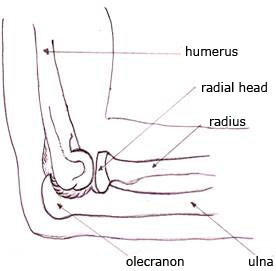Radial Head Fractures
Home / RH-Fractures
"Radial head fractures are common injuries, often caused when trying to break a fall by putting your hand out in front of you" - Dr Duckworth
The radius is one of the bones of the forearm which extends from the elbow to the wrist
The radius is one of the bones of the forearm which extends from the elbow to the wrist. The portion of the radius at the elbow joint is referred to as the radial head.
Radial head fractures are common injuries, often caused when trying to break a fall by putting your hand out in front of you. The force and mechanism of the fall can cause a dislocation of your elbow. After the dislocation, as the bone slides back into its appropriate place, it can chip off a piece of the radial head, resulting in a fracture.
What are the symptoms?
The symptoms include:
- Pain on the outside of the elbow
- Swelling of the elbow
- Difficulty in bending or straightening the elbow accompanied by pain
- Inability or difficulty in turning the forearm (palm up to palm down or vice versa)


What is the treatment?
Radial head fractures are classified according to the degree of displacement (variation from the normal position). Displacement can range from a small crack, to a displaced larger fragment, to shattering of the head into more than one piece. It will depend on the type & severity of the fracture as to whether or not surgical intervention is required.
For those fractures which are displaced, surgical repair has been found to provide the best outcome with a faster return to pre-injury activities.
How is the operation done?
The operation involves coming into hospital overnight and the operation takes about an hour.
Under a general anaesthetic, a 5-7 cm incision is made on the outside of the elbow. The radial head and fracture fragments are located, returned to their original position and held in place with screws. The screws are left in permanently.


Complications related to the surgery can occur but are rare. A general anaesthetic is used and there are risks related to this, which you should discuss with your Anaesthetist. Some of the other risks include infection, nerve and blood vessel damage. There is a risk of loss of extension of the affected arm and of failure of the procedure and therefore the need for revision surgery. Other risks include loss of full movement, particularly extension of the elbow and early arthritic change in the joint.
The majority of patients recover within three months of the surgery. Most patients do not require a plaster and will start moving their arm the day after their surgery. In complex cases a half plaster or backslab will be worn for 1-2 weeks after surgery and then gentle mobilisation will begin.
Frequently asked questions
No, the screws remain in place.
Usually between 2 to 3 weeks after surgery.
A general rule is between 6-8 weeks as long as the bones have healed adequately. Every fracture however is different and some athletes return earlier or later depending on the circumstances.
Usually within a week if you perform desk work only. Physical work could take 6- 8 weeks to return to.
No, you will not require a plaster cast. You will need to wear a sling for 1-2 weeks as long as you are careful.
No. You are encouraged to gently begin to use your arm immediately after surgery letting pain be your guide as to what you do. Common sense should prevail if it hurts, don't do it!
For appointments and enquiries, please phone (02) 9806 3333
8am to 5pm, Monday to Friday
Or send us a message on our Contact page.
Information
Phone
02 9806 3333
drduckworth@specortho.com.au
SAN CLINIC
Suite 601B
185 Fox Valley Rd
Wahroonga, NSW 2076
NORWEST PRIVATE HOSPITAL
G18 -Ground Floor
11 Norbik Drive
Bella Vista, NSW 2153
